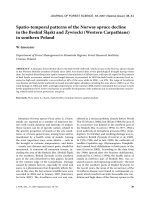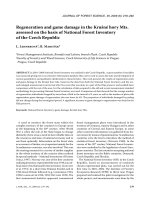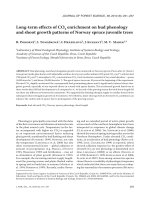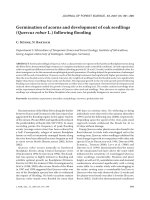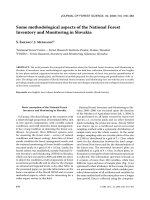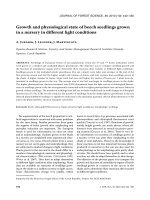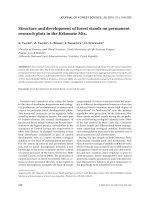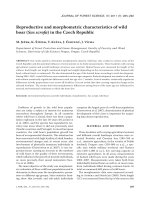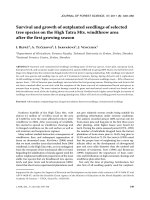Báo cáo lâm nghiệp: "Germination and storage of recalcitrant seeds of tropical forest tree specie" pdf
Bạn đang xem bản rút gọn của tài liệu. Xem và tải ngay bản đầy đủ của tài liệu tại đây (141.07 KB, 3 trang )
Germination
and
storage
of
recalcitrant
seeds
of
some
tropical
forest
tree
species
F. Corbineau
D .Côme
Laboratoire
de
Physiologie
des
Organes
V6g6taux
apr6s
Recolte,
CNRS,
Meudon,
and
Université
Pierre-et-Marie-Curie
(Paris
VI),
Paris,
France
Introduction
Seeds
have
been
termed
orthodox
or
recalcitrant
by
Roberts
(1973)
to
describe
their
storage
behavior.
Orthodox
seeds
tolerate
dehydration
down
to
5-10%
(dry
weight
basis)
without
damage.
Prepared
in
this
manner,
these
seeds
can
be
stored
for
long
periods
and
their
viability
can
be
prolonged
at
the
lowest
temperature
and
moisture
content
possible.
Recalcitrant
seeds
are
highly
hydrated
and
they
cannot
withstand
intensive
desiccation.
They
originate
predominantly
from
tropical
or
subtropical
tree
species.
These
seeds
can
only
be
stored
in
wet
medium
to
avoid
desiccation
injury
and
at
relatively
warm
temperature,
since
most
of
them
are
sen-
sitive
to
chilling
(King
and
Roberts,
1979).
The
aim
of
the
present
study
was
to
analyze
the
germination
of
some
recalci-
trant
seeds
of
tropical
forest
trees,
and
the
effects
of
dry
and
wet
storage
on
their
via-
bility.
*
New
address:
Laboratoire
de
Physiologie
V6g6tale
Apr
Materials
and
Methods
Experiments
were
carried
out
with
seeds
of
two
Dipterocarps
collected
in
Thailand
at
the
Phu
Khac
Botanical
Garden
(Shorea
roxburghii)
and
the
Meak
Lek
Arboretum
(Hopea
odorata),
and
seeds
of
Simarouba
amara
(Simaroubaceae)
and
Symphonia
globulifera
(Guttiferae)
collected
in
the
dense
forest
near
Kourou,
French
Guiana.
Germination
tests
were
performed
in
dark-
ness,
at
temperatures
between
5
and
35°C,
on
cotton
wool
saturated
with
deionized
water
and
placed
in
plastic
rectangular
boxes
(18
cm
long
x
12
cm
wide
x
5.5
cm
deep).
50-100
seeds
were
used
in
each
test
(10-25
seeds
per
box).
To
study
the
effect
of
dehydration
on
viability,
seeds
were
placed
in
open
air
at
20°C
and
55%
relative
air
humidity.
Samples
were
periodically
removed,
weighed
and
placed
for
germination
at
30°C.
Viability
was
expressed
by
the
maxi-
mal
germination
percentage.
Mois
h
;a
content
was
calculated
on a
fresh
weight
basis.
Wet
storage
was
performed
at
5,
8,
10,
12,
15
and
20°C,
on
cotton
wool
imbibed
with
deio-
nized
water
after
seed
treatment
with
quinolate
(copper
oxyquinoleate).
Viability
was
periodical-
ly
tested
by
transferring
seeds
to
30°C.
All
results
concern
seeds
visually
healthy
at
harvest
time.
Jliquée.
4,
pl.
Jussieu.
Tour
53,
75230
Paris
Cedex
05,
*
New
address:
Laboratoire
de
Physiologie
V6g6tale
Apphqu£e,
4,
pl.
Jussieu,
Tour
53,
75230
Paris
Cedex
05,
France.
Results
Germination
of
freshly
harvested
seeds
Freshly
harvested
seeds
had
no
dorman-
cy.
In
all
cases,
germination
was
best
at
relatively
high
temperatures
(optimum
at
25-30°C)
(Fig.
1
Below
15°C,
it
was
reduced
(Shorea
roxburghii)
or
impossible
(Symphonia
globulifera
and
Simarouba
amara),
but
h’opea
odorata
seeds
germi-
nated
even
at
5°C.
Effect
of
dry
storage
Initially,
the
mean
moisture
content
of
seeds
was
relatively
high:
67%
for
Sym-
phonia
globulifera,
39%
for
Simarouba
amara,
33%
for
Hopea
odorata
and
26%
for
Shorea
roxt
’
urg/7/7.
All
seeds
were
dead
when
their
mean
moisture
contents
decreased
to
about
8%
for
Simarouba
amara,
15%
for
Shorea
roxburghii
and
I i - 1 11
I
Hopea
odorata
and
26%
for
Symphonia
globulifera
(Fig.
2).
Simarouba
seeds
remained
viable
at
relatively
low
moisture
content,
but
they
produced
abnormal
seedlings.
Effects
of
wet
storage
Seeds
often
started
to
germinate
during
storage.
Moreover,
seeds
or
seedlings
were
easily
injured
by
chilling
when
the
temperature
decreased
below
10°C
for
Shorea
roxburghii,
15°C
for
Symphonia
globulifera
and
20°C
for
Hopea
odorata
and
Simarouba
amara
(Fig.
3).
At
temperatures
that
do
not
result
in
chilling
injury,
seedling
growth
was
too
fast
to
allow
extended
storage.
Storage
duration
did
not
exceed
2-3
months
except
for
Symphonia
globulifera
(2-3
y
at
15°C).
Discussion
and
Conclusion
Seeds
of
Shorea
roxburghii,
Hopea
odo-
rata,
Symphonia
globulifera
and
Simarou-
ba
amara
are
not
dormant
and,
as
for
many
other
tropical
species
(Come,
1982),
they
germinate
easily
at
high
tempera-
tures.
However,
seeds
of
Hopea
odorata
are
also
able
to
germinate
at
relatively
low
temperatures
(5°C).
They
are
highly
hydrated
and
lose
viability
when
the
mois-
ture
content
decreases.
They
are
typical
recalcitrant
seeds
whose
sensitivity
to
desiccation
depends
upon
the
species
(King
and
Roberts,
1979;
Corbineau
and
C6me,
1988).
Dry
storage
is
impossible
and
wet
storage
is
difficult,
because
the
temperature
must
be
low
enough
to
pre-
vent
germination
or
reduce
the
rate
of
seedling
growth,
but
a
relatively
low
temperature
is
linked
to
a
risk
of
chiiling
injury.
So
far,
long-term
storage
methods
for
recalcitrant
seeds
of
tropical
forest
trees
do
not
exist.
Use
of
solutions
with
a
suitable
osmotic
pressure
to
avoid
germi-
nation
and
growth
or
of
cryoprotective
agents
to
enable
seeds
or
young
seed-
lings
to
withstand
low
storage
tempera-
tures
are
perhaps
possible
approaches
to
increase
storage
life.
References
C6me
D.
(1982)
Germination.
In:
Croissance
et
D6veloppement
Physiologie
V6g6tale
M
(P.
Mazliak
ed.),
Hermann,
Paris,
pp.
129-225
Corbineau
F.
&
C6me
D.
(1988)
Storage
of
recalcitrant
seeds
of
four
tropical
species.
Seed Sci.
Technol.
16,
97-103
King
M.W.
&
Roberts
E.H.
(1979)
The
storage
of
recalcitrant
seeds.
Achievements
and
pos-
sible
approaches.
International
Board
for
Plant
Genetic
Resources,
Rome
Roberts
E.H.
(1973)
Predicting
the
storage
life
of
seeds.
Seed Sci.
Technol.
1,
499-514
4

